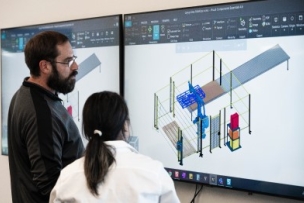As various segments of the industry come back online, will your workforce be ready to meet a rise in product demand?
Make Best Use of Existing Resources and Workers
In the near term, manufacturing companies must look to maximize the resources and staff they have on hand.
Automation is one way to accomplish this. “Manufacturers that have piloted [automation] solutions should ramp them up carefully, while others should start exploring them,” consulting firm PwC advises.
The key words here are “carefully” and “exploring.” Given the delicate economic climate, now may not be the right time for companies to make sizable investments in new technologies.
But for those that are well positioned and willing to try, focusing on a few areas of automation can make the most of a reduced workforce, PwC advises. Those areas are:
- Autonomous materials movement, such as forklifts and cranes.
- Automation of repetitive tasks in assembly, such as industrial robotics and collaborative robots.
- Predictive maintenance using the Internet of Things and artificial intelligence.
Read more: Automation Nation: Reduce Setups and Repetitive Stress Work in Manufacturing
Automation will also bring about a need for certain soft skills in the workplace.
Jasmeet Singh, executive vice president and global head of manufacturing at Infosys, wrote in Industry Week: “Beyond purely technical skills, skills increasingly needed are complex problem-solving, critical thinking and creativity. An example of upskilling would be training workers who have an aptitude for it in data and analytics skills. This will enable them to contribute to increasingly mission-critical tasks such as demand forecasting.”
Singh shared an example of GE Appliances opening a new plant featuring Industry 4.0 technologies such as data visualization, 3D scanning and rapid prototyping.
“To prepare workers for this modern manufacturing facility,” he wrote, “the GE Appliances team conducted hydraulics training through a local supplier and implemented on-site training in order to reskill its employees for the new factory floor.”
Read more: Stay up to date on metalworking career trends from Better MRO
Begin to Rebuild Your Workforce
When more workers are needed to meet increasing production demand, companies may find it surprisingly difficult to rehire.
While a worker shortage seems counterintuitive given the country’s record unemployment numbers, Ethan Karp, CEO of Magnet, a consulting group for the manufacturing industry, points to a talent problem that precedes the COVID-19 pandemic.
There is an opportunity to lay the foundation—or build on the one you’ve already started—to create a strong recruiting and hiring program for the future. He offered the following advice in a webinar hosted by Industry Week.
1. Be innovative with recruiting. Instead of going to the same places and using the same tactics to find the right talent, go to where the people are—namely, social media—and make your company appealing in that space. Companies have found success by using Spotify, Snapchat and text messages in their recruiting, Karp said. Don’t be afraid to try different avenues and find what works for you, he said.
2. Tell your company’s unique story. Millennials make up the largest pool of potential workers, and they generally aren’t choosing to work in manufacturing. Attract millennials to manufacturing by sharing stories that illustrate how manufacturing—how your company—is a career of opportunity, Karp said. “They want to know that your product is helping people,” he said. “They want to know that there’s a significant opportunity for advancement and lucrative pay. We can show them that.”
Read more: They’re Already Doing It: The Millennial Machinists Helping the Skills Shortage
3. Cast a wider recruiting net. In manufacturing, 71 percent of workers are male, and 80 percent are white, according to the U.S. Bureau of Labor Statistics. Think about the makeup of your community and the demographics that are underrepresented in your workplace. In doing so, you’ll find a much greater pool of skilled workers to recruit from.
4. Treat your workers well. “When you build a great place to work, your employees talk about it, and that helps draw more great talent to you,” Karp said. If you don’t know what your employees think about the company, ask them.
5. Invest in training. “New technologies are constantly coming onto the floor,” Karp said. “Since we can’t always find the skilled talent we need to run that equipment, we need to figure out how to upskill that talent inside our own plants.” Consider traditional means, such as online training and college classes, and newer methods, such as augmented reality and virtual reality.
MSC has partnered with Tooling U-SME, a leader in manufacturing for nearly 90 years, to offer online training packages that support core manufacturing roles by helping develop and maintain the necessary skills to keep up with new innovations and advanced manufacturing.
 Learn More and Start Your FREE Trial Today
Learn More and Start Your FREE Trial Today
6. Create an apprenticeship program. Through paid, on-the-job training and classroom education, apprenticeships attract and keep people in manufacturing. “The strategy helps businesses thrive by building a highly skilled, highly productive workforce, and it helps job seekers access and maintain stable careers with good wages,” the U.S. Department of Labor says, noting that more than 91 percent of apprentices are still employed by the company nine months later. To start, Karp said, companies can connect with local colleges or high schools that might have a program, or they can reinstate one that hasn’t been used in a while.
Read more: 4 Proven Methods for Filling Local Manufacturing Jobs




Talk to Us!
Leave a reply
Your email address will not be published. Required fields are marked *